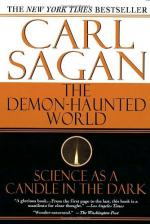|
This section contains 742 words (approx. 2 pages at 400 words per page) |

|
The Demon-Haunted World Summary & Study Guide Description
The Demon-Haunted World Summary & Study Guide includes comprehensive information and analysis to help you understand the book. This study guide contains the following sections:
This detailed literature summary also contains Topics for Discussion and a Free Quiz on The Demon-Haunted World by Carl Sagan.
Popular science proselytizer Carl Sagan makes an impassioned plea for society to understand, accept and encourage science that goes far beyond the movement of planets or subatomic particles and extends to the heart of intellectual freedom and the meaning of democracy. Many may know the astronomer primarily from his television appearances as popular conduit to understanding the rarefied atmosphere of pure science. They may be startled at the ferocity and elegance with which Sagan attacks what could be called the approach of the second Dark Ages.
The text begins as a scholarly and deliberate attempt to explain how important intellectual curiosity is to science. It evolves into an impassioned statement for personal and intellectual freedom as understood during and after the Enlightenment. This was manifested in such uniquely American treasures as the Declaration of Independence through thought leaders like Thomas Jefferson. Sagan draws parallels between independent thinkers in science who explored unknown territories that have enriched everyone's lives and independent political thinkers such as Jefferson (who also was a scientist) who gave legal form to basic freedoms.
Sagan exults over his love of science as he warns about the "dumbing down" of America. This is reflected not only in popular anti-intellectual television fare but also in a steady decline in competitive/comparative test scores that now place American school children well behind most students of other industrialized nations on basic science and math skills. He then compares the loss of scientific literacy to language literacy. He also notes the intrusion of faith-based beliefs into our system of government and politics. Sagan sounds an alarm that funding for basic scientific research should not be cut.
If the spirit of scientific inquiry was handed down to western civilization largely from the ancient Greeks—along with the idea of democracy—so was an appreciation for skepticism, useful in both areas, according to Sagan. This he refers to as "The Fine Art of Baloney Detection." In one of his most sparkling chapters, he describes the process in detail and gives instructions for the gullible, the lazy, and the ideologically warped. As the author warms to his topic in a white hot fire of intensity, the amiable, easy-going persona of Carl Sagan, television guide to the solar system, slips away. The reader hears Sagan's voice rise in pitch until it is a call to arms for nothing less than the preservation of civilization, itself. Even the chronically incurious reader will be compelled to read on to find out what has Dr. Sagan so perturbed.
The astronomer's approach to his subject is to catalogue and describe in vivid detail the many demons, myths, gods, devils and strange obsessions that continue to plague humanity through the ages. He then describes how science emerged from this darkness as a candle of light and hope. It illuminated the way to truly stupendous advances by human beings in a few centuries. As science has upset some truly ancient religious beliefs in its evolution, it has also upset some clergy. They've responded with witch hunts, torture chambers, executions, excommunications, and truly mind-boggling contemporary brainwashing campaigns. Each questions basic notions about where we as a species came from and are headed. Without condemning these reactionary trends per se, Sagan explains that there is a better way to understand such matters. The answer is science.
For example, Sagan frankly admits he'd love to know that flying saucers are transporting highly intelligent and technologically advanced beings to Earth from another galaxy. In fact, Sagan was one of the prime moving forces behind establishment of the Search for Extraterrestrial Intelligence (SETI) project that has been de-funded by Congress. However, he says there hasn't been a shred of scientific evidence that supports any of the claims about UFOs (unidentified flying objects) other than the sort of mass hysteria testimonies of witnesses and supposed abductees. Nothing can be scientifically measured, studied or analyzed. The UFO phenomenon, according to Sagan, reflects a sort of primitive religious impulse combined with a genuine sense of awe about the universe.
Science gives a focus to these very human impulses and a proven method for discerning truth and discarding "baloney," Sagan tells his readers. He emphasizes that one does not need to be a scientist to appreciate and use the scientific method. based on reason, it can sort through the myriad of irrational demons set loose in the modern world that threaten the very core of our civilization.
Read more from the Study Guide
|
This section contains 742 words (approx. 2 pages at 400 words per page) |

|



